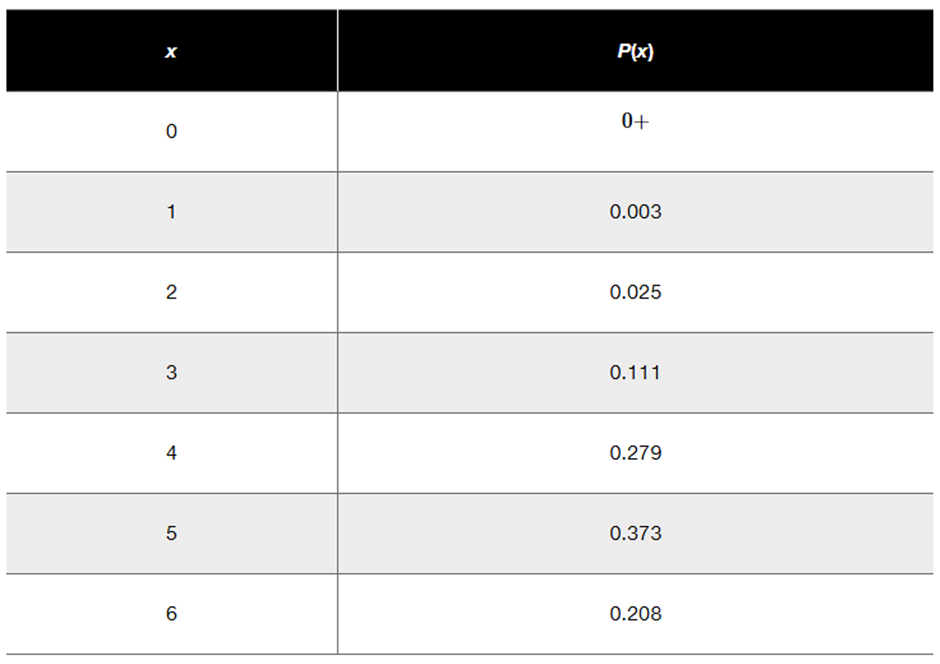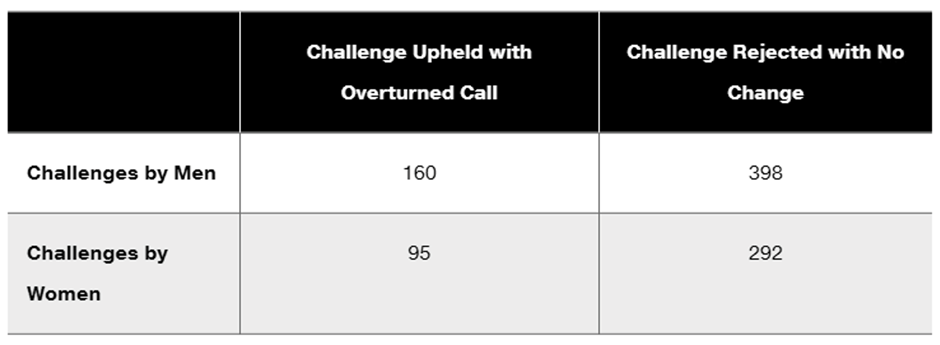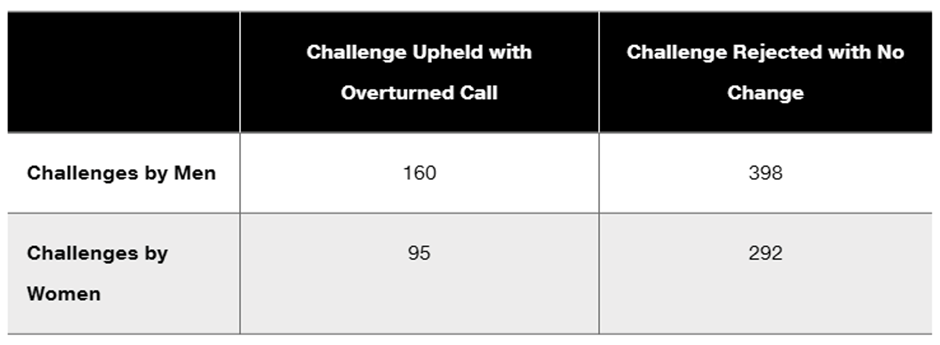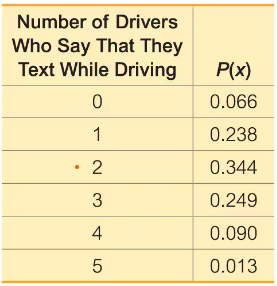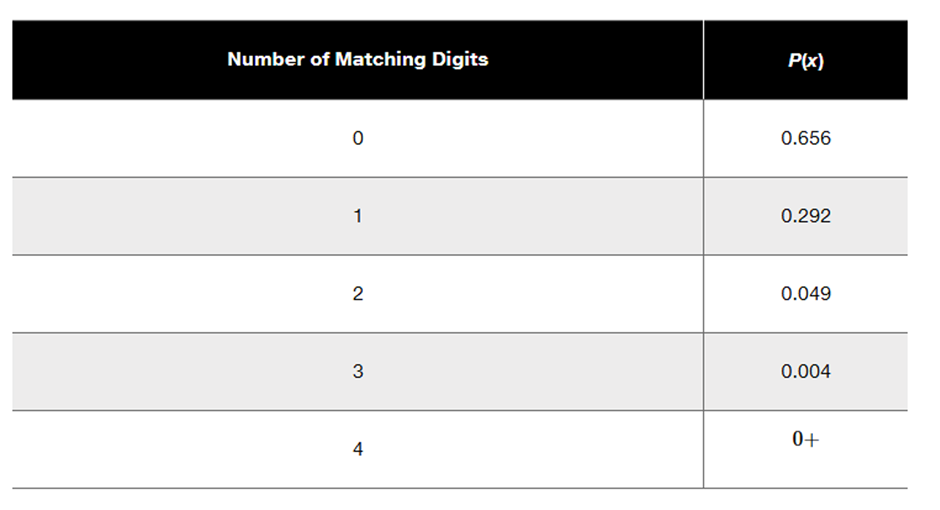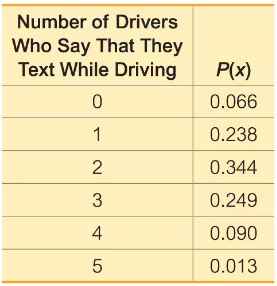 Back
BackProblem 5.c.4a
Salary Negotiations In a Jobvite survey, 2287 adult workers were randomly selected and asked about salary negotiations.
a. 29% of the respondents reported that they negotiated salary at their latest job. What is the number of respondents who reported that they negotiated salary?
Problem 5.c.4b
Salary Negotiations In a Jobvite survey, 2287 adult workers were randomly selected and asked about salary negotiations.
b. Among those who negotiated salary, 84% received higher pay. How many received higher pay?
Problem 5.c.8
Happiness In a survey sponsored by Coca-Cola, subjects were asked what contributes most to their happiness, and the table summarizes their responses. Does the table represent a probability distribution? Explain.
Problem 5.RE.8
Family/Partner Groups of people aged 15–65 are randomly selected and arranged in groups of six. The random variable x is the number in the group who say that their family and/or partner contribute most to their happiness (based on a Coca-Cola survey). The accompanying table lists the values of x along with their corresponding probabilities. Does the table describe a probability distribution? If so, find the mean and standard deviation.
Problem 5.CRE.2a
Kentucky Pick 4 In the Kentucky Pick 4 lottery game, you can pay $1 for a “straight” bet in which you select four digits with repetition allowed. If you buy only one ticket and win, your prize is $2500.
a. If you buy one ticket, what is the probability of winning?
Problem 5.CRE.2b
Kentucky Pick 4 In the Kentucky Pick 4 lottery game, you can pay $1 for a “straight” bet in which you select four digits with repetition allowed. If you buy only one ticket and win, your prize is $2500.
b. If you play this game once every day, find the mean number of wins in years with exactly 365 days.
Problem 5.CRE.2c
Kentucky Pick 4 In the Kentucky Pick 4 lottery game, you can pay $1 for a “straight” bet in which you select four digits with repetition allowed. If you buy only one ticket and win, your prize is $2500.
c. If you play this game once every day, find the probability of no wins in 365 days.
Problem 5.CRE.3a
Tennis Challenge In a recent U.S. Open tennis tournament, there were 945 challenges made by singles players, and 255 of them resulted in referee calls that were overturned. The accompanying table lists the results by gender.
a. If 1 of the 945 challenges is randomly selected, what is the probability that it resulted in an overturned call?
Problem 5.CRE.3b
Tennis Challenge In a recent U.S. Open tennis tournament, there were 945 challenges made by singles players, and 255 of them resulted in referee calls that were overturned. The accompanying table lists the results by gender.
b. If one of the overturned calls is randomly selected, what is the probability that the challenge was made by a woman?
Problem 5.CRE.3c
Tennis Challenge In a recent U.S. Open tennis tournament, there were 945 challenges made by singles players, and 255 of them resulted in referee calls that were overturned. The accompanying table lists the results by gender.
c. If two different challenges are randomly selected without replacement, find the probability that they both resulted in an overturned call.
Problem 5.Q.4
Find the mean of the random variable x described in the preceding exercise.
Problem 5.Q.5
Is the mean found in the preceding exercise a statistic or a parameter?
Problem 5.R.10a
Poisson: Deaths Currently, an average of 7 residents of the village of Westport (population 760) die each year (based on data from the U.S. National Center for Health Statistics).
a. Find the mean number of deaths per day.
Problem 5.R.10b
Poisson: Deaths Currently, an average of 7 residents of the village of Westport (population 760) die each year (based on data from the U.S. National Center for Health Statistics).
b. Find the probability that on a given day, there are no deaths.
Problem 5.R.10c
Poisson: Deaths Currently, an average of 7 residents of the village of Westport (population 760) die each year (based on data from the U.S. National Center for Health Statistics).
c. Find the probability that on a given day, there is more than one death.
Problem 5a
In Exercises 5–8, assume that the Poisson distribution applies; assume that the mean number of Atlantic hurricanes in the United States is 5.5 per year, as in Example 1; and proceed to find the indicated probability.
Hurricanes
a. Find the probability that in a year, there will be 7 hurricanes.
Problem 5b
In Exercises 5–8, assume that the Poisson distribution applies; assume that the mean number of Atlantic hurricanes in the United States is 5.5 per year, as in Example 1; and proceed to find the indicated probability.
Hurricanes
b. In a 118-year period, how many years are expected to have 7 hurricanes?
Problem 5.1.24
Texting and Driving. In Exercises 21–26, refer to the accompanying table, which describes probabilities for groups of five drivers. The random variable x is the number of drivers in a group who say that they text while driving (based on data from an Arity survey of drivers).
Using Probabilities for Significant Events
a. Find the probability of getting exactly 3 drivers who say that they text while driving.
Problem 5.1.29b
Expected Value for the Florida Pick 3 Lottery In the Florida Pick 3 lottery, you can bet $1 by selecting three digits, each between 0 and 9 inclusive. If the same three numbers are drawn in the same order, you win and collect $500.
b. What is the probability of winning?
Problem 5.1.30a
Expected Value in North Carolina’s Pick 4 Game In North Carolina’s Pick 4 lottery game, you can pay $1 to select a four-digit number from 0000 through 9999. If you select the same sequence of four digits that are drawn, you win and collect $5000.
a. How many different selections are possible?
Problem 5.1.4
Significant For 100 births, P(exactly 56 girls) and P(56 or more girls) Is 56 girls in 100 births a significantly high number of girls? Which probability is relevant to answering that question?
Problem 5.1.17
Lottery. In Exercises 15–20, refer to the accompanying table, which describes probabilities for the California Daily 4 lottery. The player selects four digits with repetition allowed, and the random variable x is the number of digits that match those in the same order that they are drawn (for a “straight” bet).
Range Rule of Thumb for Significant Events Use the range rule of thumb to determine whether 4 matches is a significantly high number of matches.
Problem 5.1.18a
Lottery. In Exercises 15–20, refer to the accompanying table, which describes probabilities for the California Daily 4 lottery. The player selects four digits with repetition allowed, and the random variable x is the number of digits that match those in the same order that they are drawn (for a “straight” bet).
Using Probabilities for Significant Events
a. Find the probability of getting exactly 2 matches.
Problem 5.1.18b
Lottery. In Exercises 15–20, refer to the accompanying table, which describes probabilities for the California Daily 4 lottery. The player selects four digits with repetition allowed, and the random variable x is the number of digits that match those in the same order that they are drawn (for a “straight” bet).
Using Probabilities for Significant Events
b. Find the probability of getting 2 or more matches.
Problem 5.1.19a
Lottery. In Exercises 15–20, refer to the accompanying table, which describes probabilities for the California Daily 4 lottery. The player selects four digits with repetition allowed, and the random variable x is the number of digits that match those in the same order that they are drawn (for a “straight” bet).
Using Probabilities for Significant Events
a. Find the probability of getting exactly 3 matches.
Problem 5.1.19b
Lottery. In Exercises 15–20, refer to the accompanying table, which describes probabilities for the California Daily 4 lottery. The player selects four digits with repetition allowed, and the random variable x is the number of digits that match those in the same order that they are drawn (for a “straight” bet).
Using Probabilities for Significant Events
b. Find the probability of getting 3 or more matches.
Problem 5.1.22
Texting and Driving. In Exercises 21–26, refer to the accompanying table, which describes probabilities for groups of five drivers. The random variable x is the number of drivers in a group who say that they text while driving (based on data from an Arity survey of drivers).
Range Rule of Thumb for Significant Events Use the range rule of thumb to determine whether 4 is a significantly high number of drivers who say that they text while driving.
Problem 5.1.19c
Using Probabilities for Significant Events
c. Which probability is relevant for determining whether 3 is a significantly high number of matches: the result from part (a) or part (b)?
Problem 5.1.20a
Using Probabilities for Significant Events
a. Find the probability of getting exactly 1 match.
Problem 5.1.20b
Using Probabilities for Significant Events
b. Find the probability of getting 1 or fewer matches.


